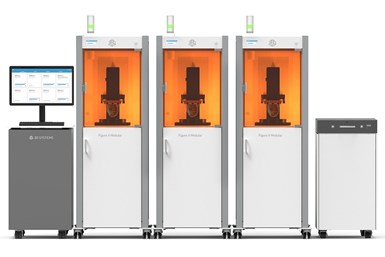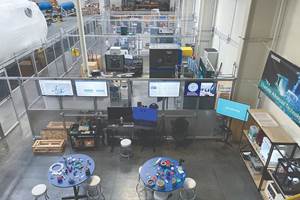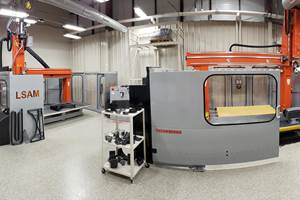3D Systems Helps TE Connectivity to Additively Manufacture Electrical Connectors
The foundation of the solution is a newly developed photopolymer 3D Systems engineered specifically to meet TE Connectivity’s requirements.
3D Systems collaborated with TE Connectivity to jointly develop an additive manufacturing (AM) solution to produce electrical connectors meeting stringent UL regulatory requirements. The solution comprising 3D Systems’ Figure 4 Modular, Figure 4 material, 3D Sprint software and services was designed to meet TE Connectivity’s unique requirements for material performance and high tolerance, reliable printing.
The foundation of the solution is a newly developed photopolymer which 3D Systems engineered specifically to meet TE Connectivity’s requirements. In addition to a world-class flammability rating at 0.4mm thickness, it is the first known printable photopolymer to complete a UL 1-recognized long-term thermal aging (RTI) study.
This material combined with an optimized print process enables the necessary reliability and accuracy required for TE Connectivity’s products. Using 3D Systems’ Figure 4 technology, the combination of new material properties, speed and accuracy enables the production of rugged industrial products for the first time, targeted at appliances, cellular and data center applications.
AM gives TE Connectivity freedom of design to create complex geometries that would be difficult to create using injection molding. It increases flexibility for low-volume, quick-turn production runs and tooling avoidance, enabling TE to quickly demonstrate its capabilities and its customers to more efficiently meet demand.
The novel workflow enables production of end-use parts in weeks versus months without tooling investment, while the unique photopolymer offers full UL recognition capable of meeting stringent connector application needs. It is the first known 3D photopolymer to complete long-term thermal aging for electrical and mechanical relative thermal index (RTI) certification.
3D Systems’ Application Innovation Group (AIG) collaborated with TE Connectivity’s team to develop a full production workflow from design to a finished connector. The program included the development and UL certification of a new Figure 4 material. UL regulatory approval has been obtained, including UL94 V0 flame rating at 0.4 mm, Glow Wire Ignition (GWI) of 800°C, Comparative Tracking Index (CTI) of 600 V (equivalent to a PLC of 0), and Relative Temperature Index (RTI) for long-term electrical and mechanical use of 150C and 130C, respectively.
“As 3D printing technology evolves, we’re seeing more opportunities for using it to manufacture products for customers who need a low volume of parts in a short time frame,” says Philip Gilchrist, vice president and segment chief technology officer for Communications Solutions at TE Connectivity. “Our work with 3D Systems enables us to provide our customers with functional parts in just weeks instead of months.”
3D Systems says customer-centric innovation is at the core of everything it does. “The collaboration with TE Connectivity provided the understanding and requirements of the unique application being addressed and enabled the development of the solution,” says Reji Puthenveetil, executive vice president, industrial solutions, 3D Systems. “Our materials scientists and print process experts worked very closely with the TE team to formulate a material that, when used in conjunction with our Figure 4 technology, delivered on the high quality, high-reliability standards their customers have come to expect. This is yet another example of how 3D Systems is partnering with industry leaders to accelerate innovation and build competitive advantage through additive manufacturing solutions.”
- Check out this article about 10 Important Developments in Additive Manufacturing Seen at Formnext 2022, including 3D Systems’ redesign for the frame and structure of its machines. One big change: The mechanics of the machine have been moved to the side, so the back of the machine can be opened for robot access.
- In this product post, we talk about two offerings from 3D Systems that are production-grade materials designed to address a breadth of industrial applications.
- In this article about 3D Systems partnering with Ems-Griltech, we learn how the companies are working to advance materials innovation by producing DuraForm PAx Natural, a material available for all selective laser sintering platforms.
Related Content
Safer Nuclear Energy: 3D Printed Silicon Carbide Fuel Forms
Binder jetting provides a way to create pure silicon carbide fuel structures that can withstand the harsh environment of a nuclear reactor and provide a strong barrier against the release of radionuclides.
Read MoreAdvancing Additive Manufacturing With a CATCH and Release Approach
Solutions for energy efficiency, sustainability, part repair and more are developing at Siemens’ Charlotte Advanced Technology Collaboration Hub (CATCH) in North Carolina.
Read MoreDOE Awards Nearly $3 Million to Develop Additive Manufacturing of Modular Wind Blades
The industry partners received the award to develop automation in additive manufacturing of tooling for large-scale wind blades that can accommodate continuous changes in blade geometry and scale.
Read More3D Printed Spares, Electrification and Cool Parts: Top 10 Stories of 2022: AM Radio #31
Our top articles and videos from 2022 reflect increasing use of additive manufacturing for replacement parts; growing applications for electric motors; and a maturing user base. Read through the top 10 list or listen to the AM Radio podcast episode all about these stories.
Read MoreRead Next
4 Ways the Education and Training Challenge Is Different for Additive Manufacturing
The advance of additive manufacturing means we need more professionals educated in AM technology.
Read More3D Printing Brings Sustainability, Accessibility to Glass Manufacturing
Australian startup Maple Glass Printing has developed a process for extruding glass into artwork, lab implements and architectural elements. Along the way, the company has also found more efficient ways of recycling this material.
Read MoreHybrid Additive Manufacturing Machine Tools Continue to Make Gains (Includes Video)
The hybrid machine tool is an idea that continues to advance. Two important developments of recent years expand the possibilities for this platform.
Read More













.png;maxWidth=300;quality=90)










